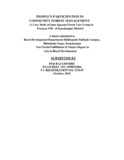Please use this identifier to cite or link to this item:
https://elibrary.tucl.edu.np/handle/123456789/855| Title: | People’s Participation in Community Forest Management (A Case Study of Jana Jagaran Forest User Group in Parasan Vdc of Kanchanpur District) |
| Authors: | Ghimire, Doj Raj |
| Keywords: | community forestry;participation management;community development |
| Issue Date: | Oct-2011 |
| Publisher: | Department of Rural Development |
| Institute Name: | Central Department of Rural Development |
| Level: | Masters |
| Abstract: | This research entitled “People’s Participation in Community Forest Management; A Case Study of Jana Jagaran Forest User Group in Parasan VDC of Kanchanpur District” is conducted in Parasan VDC of Kanchanpur district. It is a case study conducted on a small area but this research contributes valuable information on issues of participation equity and management in community forestry development at district and national level. The overall objectives of the study is also to access the “people’s participation in community forest management”. However, the specific objective are to analyze the socio-economic characteristics of the respondent, to analyze the existing community forest management system in the study area, to know how the people are involved in CFM system and lastly to find out the problem related to the well functioning of FUG in the Parasan VDC. The study is exploratory as well as descriptive in nature. It is based on a sample of 40 households as selected by using simple random sampling techniques. The data were obtained through interview schedule, observation, focus group discussion and check-list. Both primary and secondary data are used for the research. Data has shown that male population is slightly dominant by female as well as the age 16-59 is high in the study area. The economically active population is 50.15 %. In the case of education 22% of the respondents were illiterate. After the community forest program was launched, the forest of Parasan VDC was handed to local people by the government. The overall forest management system in JJFUG is described under four categories: Operation management, Protection management, Utilization management, Promotion and development management. After the people’s participation in JJFUG, people of the study area were conscious about the activities related to CF. The data shows that 35% of the female respondents were actively participated in the meeting. But on the other hand 8% of the women were only participated in decision making process; this shows that the female percentage is lower than male in decision making process. The finding of the study reveals that 78% of the total respondents are at least literate. The greater percentage of the population is engaged in agriculture. But in the case of conflict regarding management of forest, there still exist on conflict over access, conflict due to resource availability and conflict in sharing benefit. The FUG has been playing role for the development of local human resource and also enhance the rural livelihood. It has also empowered people towards team building, group dynamism as well as self- motivation in community development. The direct and indirect benefits from the community forestry have played the greater role in the social life of the people in the study area. Based on the above facts it can be concluded that the FUG has emerged as a viable institution for rural community development using local resources. It has been found that the FUG has maximum benefits to the underprivileged group of the community from such community development activities |
| URI: | http://elibrary.tucl.edu.np/handle/123456789/855 |
| Appears in Collections: | Rural Development |
Files in This Item:
| File | Description | Size | Format | |
|---|---|---|---|---|
| cover.pdf | 111.22 kB | Adobe PDF |  View/Open | |
| CHAPTER(1).pdf | 286.11 kB | Adobe PDF |  View/Open |
Items in DSpace are protected by copyright, with all rights reserved, unless otherwise indicated.
